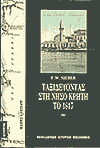|
F. W. Sieber (1789-1845) was
born and died in Prague. He studied medicine and botany. In 1817 Sieber
was sent to Crete to do various researches there by the Botanical
Association of Regensburg, the Imperial Academy of Munich and the
Association of Natural History in Paris. Some years later he
published his results in the book Reise nach der Insel Kreta im
griechischen Archipelagus im Jahre 1817 (Leipzig und Sorau, 1823). The
book was also published in London the same year with the title Travels
in the Island of Crete. |

|
| The English edition of the book
was translated into Greek in 1994 by D. Moustri, and this edition is the
basis of my translation. |
|
|
|
|
|
| On February 22nd [1817] I
visited Akrotiri escorted by a janizary. Until then I had brought
neither barometer nor thermometer, even a piece of paper and a pencil were
forbidden paraphernalia, so I was forced to bring them along secretly on
my excursions. (...) We were walking towards the Agia Triada monastery,
amusing ourselves on our way by collecting plants. We had passed many
hills and valleys when a row of the most magnificent cypresses I had ever
seen, appeared in the distance.
|
| (...) We followed an avenue with deep-green cypresses leading to a monastery
building, bearing a resemblance to the Arkadi monastery. To the right and
the left were vineyards and gardens with vegetables enclosed with fruit
trees. The monastery lies on the slopes of the Melecha-foreland and was
built by the Venetians. But its church is not completed.
|

|
| In former times the
monastery was wealthy, as it had many monks for the cultivation of the
land, but now it has not got enough hands - neither to gather the olives,
leaving them to fall to the ground during autumn gales, nor to sow the
fields, of which two thirds are therefore neglected.
|
| In older days more than
100 monks lived in the monastery, but when Tournefort
visited it [1699], there were only 50 left;
I myself saw only 18, including the young novices. Their lifestyle bears
witness of a deep mutual respect. Even the abbot prunes the vines, takes
care of the bees and digs the garden. His hands are the evidence of work
not being regarded as a shame here. After the morning prayers all the
monks go to their work with spades, hoes and rakes. One takes care of the
cows, another of the oven. They do not have day-labourers for the
cultivation of the land. Even the novices are peasants wanting to comply
with this lifestyle, and they wear clothing no different from other
peasants.
Neither the priests wear their
black tunics while working. (...) They work all day long, even though the
Turks purloin the best part of the harvest. Many times these come to the
monastery to take anything they want, and if resistance is put up, they
even demand money under threats of violence.
|
| The monks grow wheat, barley
and secale creticum (rye), of which they bake nice dark bread,
which has however a peculiar taste. Furthermore they grow beans, lentils,
peas that they like very much, and a sort of lupine that is quite bitter
and disgusting; and also all sorts of vegetables and herbs for cooking
plus vine, cotton, oil, a little honey, wax, butter and cheese. |
|
|
|
|

